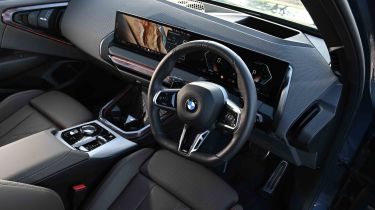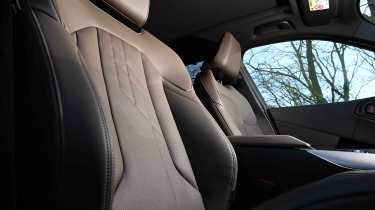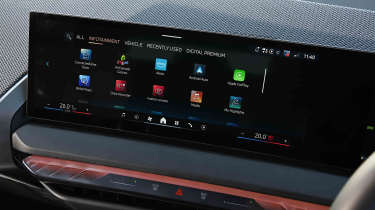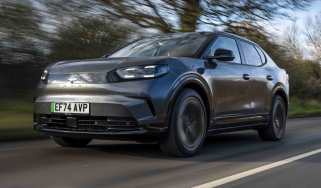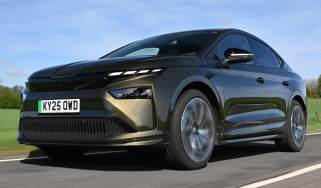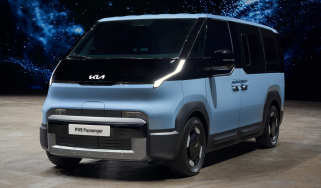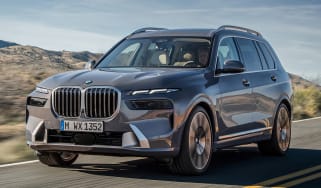BMW X3 - Interior, design & technology
There’s plenty of tech on board and a modern look, but we have questions over build quality

BMW’s exterior design language has been pretty bold of late and the X3 is no exception to this. The proportions are typical X3, but the surfacing clearly takes some influence from the all-electric BMW iX and the pronounced kidney grille, bluff front-end and pointed headlights give it a distinctive, imposing look. Compared to the rounded features of the old X3, the new one is much more crisp and certainly conveys its premium status. However, in contrast to most modern BMWs we’ve tested, a question mark or two surrounds the build quality.
LED lights are standard front and rear, but to really help the X3 stand out there’s an option to add BMW’s ‘iconic glow’ to the kidney grilles. The headlights can be specified with adaptive matrix high beams, and are also offered with a standard or ‘shadowline’ finish with blue internal elements.
The M Sport package isn’t just for the M50, as it’s offered on all powertrains. It adds 19-inch alloy wheels over the xLine’s 18-inch rims, a more aggressive front bumper with gloss black inserts and a larger lower intake, body-coloured side skirts and a different rear spoiler – again, with more gloss black on show. An M Sport package, Pro, builds on this by adding the illuminated grille and red brake calipers.
Used - available now
BMW offers one solid shade and eight metallics for the new X3 – including a new ‘Dune Grey’ metallic finish. The one, non-metallic choice is a plain ‘Alpine White’, while ‘Fire Red’ and ‘Tanzanite Blue’ are the most eye-catching hues on offer, outside the selection of ‘BMW Individual’ paint finishes.
What is the BMW X3 like inside?
In terms of design, the X3 takes a leaf from the book of its all-electric big brother, the iX. A pair of digital displays are housed within one continuous and gently curving panel, around which is a choice of materials. Whether a leather-effect finish or a more textured fabric – the latter is made from recycled polyester – each covers the entire surface of the dashboard and looks good. The central air vents are slim, hidden beneath what is one of the most prominent features of the cabin.
The illuminated “Interaction bar” runs across the centre of the dash, and creates a U-shaped section around the smartphone charging pad and two C-shaped panels that surround the car’s door handles. The flat-bottomed steering wheel looks smart, but as is the case with all current BMWs, it feels a little too thick for our liking.
BMW gives buyers a reasonable level of scope for customisation both inside and out. Those who want a full leather interior can go for a snazzy tan/grey combination or a fully black finish, while artificial leather is offered in brown, cream or black. There’s even a fabric option, with the woven grey material adding some extra interest inside. On the outside, wheel sizes range from 18 to 21 inches, and there are nine exterior paint finishes to choose from – white is the only no-cost option.
What is the interior quality like?
The interior feels mostly well screwed together and the surfaces are largely tactile to the touch. The one exception, notably, is an element you encounter every time you use the car: the door handles feel like they’re made from fairly cheap plastic. Even less impressive is that, in the car we tested, the panel which houses the door locking controls and electric seat memory switches had already worked its way loose. That’s strangely out of character with previous BMWs we’ve tested, and not what we’d expect to see on any new car – let alone one that is nudging £50,000.
Sat-nav, stereo and infotainment
There’s certainly a lot of wow factor to the BMW’s displays, but this is backed up with plenty of usability. While we’re disappointed that the company has ditched its physical climate controls, the on-screen arrangement the X3 uses is among the best of its type; the temperature and seat heating (where fitted) controls are a permanent fixture along the bottom of the screen. The digital dials are shown on a high-resolution display, but the boomerang-shaped scales for speed and revs aren’t as instantly clear to read as a traditional round dial would be.
While physical controls gradually die out on new cars, the X3 strikes an excellent balance. Although the climate controls are no longer actual buttons, BMW’s iDrive clickwheel remains. We’ve found that this is an ideal compromise; complex tasks such as address inputs can be carried out on the screen while parked, and the clickwheel allows for minor adjustments to be carried while you’re on the move, because they can be done by feel.
On the outside, it’s possible to make an already bold design stand out even more by opting for BMW’s ‘Iconic Glow’ exterior package. This illuminates the frame of those front kidney grilles, lending the X3 a distinctive appearance even at night.
